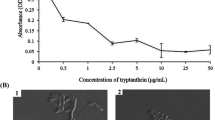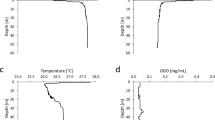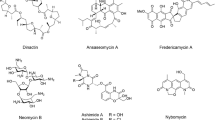Abstract
Strain CGJ02-2 was isolated from the coral reefs in South China sea and deposited in South China Sea Institute of Oceanology, Chinese Academy of Sciences. Active compounds including indole, ρ-hydroxybenzaldehyde were isolated from this strain. To explore the biosynthetic way of these compounds and search gene clusters, the complete genome of this strain was sequenced by Single Molecule, Real-Time (SMRT) technology. It was de novo assembled to two circular chromosomes of 3,400,283 bp with GC% 44.77 and 1,845,572 bp with GC% 44.59 respectively and classified as Vibrio alginolyticus. In silico phenotype features of Vibrio alginolyticus CGJ02-2 were also analyzed. The biosynthetic pathway of ρ-hydroxybenzaldehyde and indole in this strain were postulated. Gene clusters of four secondary metabolites including bacteriocin, ectoine, siderophore, arylpolyene were identified. This study provides helpful information for further utilizing Vibrio alginolyticus CGJ02-2 as a source of valuable bioactive compounds.


Similar content being viewed by others
References
Tatusov RL, Fedorova ND, Jackson JD et al (2011) The neuroprotective effects of an extract of Gastrodia elata. J Ethnopharmacol 138:1–125
Eddouks M, Bidi A, Bouhali BEL et al (2014) Insulin resistance as a target of some plant-derived phytocompounds. Stud Nat Prod Chem 43:351–373
Oh SH, Ryu B, Ngo DH et al (2017) 4-hydroxybenzaldehy-de-chitoo-ligomers suppresses H2O2-induced oxidative damage in microglia BV-2 cells. Carbohydr Res 440–441:32–37
Ha JH, Lee DU, Lee JT et al (2000) 4-hydroxybenzaldehyde from Gastrodia elata B1. Is active in the antioxidation and GABAergic neuromodulation of the rat brain. J Ethnopharmacol 73:329–333
Ku MY, Li C, Yang Z et al (2011) New progress on synthesis of ρ-hydroxybenzaldehyde. Chem. Reagents 33:1087–1094+1107
Lee JH (2010) Indole as an intercellular signal in microbial communities. FEMS Microbiol Rev 34:426–444
ShenTu YD, ShenTU Y, Jin YQ et al (2005) A simple synthetic method of indole. ZJ Chem Ind 9:24–25
Gómez CI, Zhao JP, Tan L et al (2019) Bioactive compounds isolated from marine bacterium Vibrio neocaledonicus and their enzyme inhibitory activities. Mar Drugs 17:1–19
Tan L, Yisha B, Sun XR et al (2018) Natural indole, its preparation method and application for preparing drugs for treating Alzheimer's disease or diabetes, Jul 20, CN 108299274
Lim HJ, Lee EH, Yoon Y et al (2016) Portable lysis apparatus for rapid single-step DNA extraction of Bacillus subtilis. J Appl Microbiol 120:379–387
Ardui S, Ameur A, Vermeesch JR, Hestand MS (2018) Single molecule real-time (SMRT) sequencing comes of age: applications and utilities for medical diagnostics. Nucleic Acids Res 46:2159–2168
Reiner J, Pisani L, Qiao W et al (2018) Cytogenomic identification and long-read single molecule real-time (SMRT) sequencing of a Bardet-Biedl Syndrome 9 (BBS9) deletion. NPJ Genom Med 3:1–5
Parks DH, Chuvochina M, Waite DW et al (2018) A standardized bacterial taxonomy based on genome phylogeny substantially revises the tree of life. Nat Biotechnol 36:996–1004
Emms DM, Kelly S (2015) OrthoFinder: solving fundamental biases in whole genome comparisons dramatically improves orthogroup inference accuracy. Genome Biol 16:1–14
Lowe TM, Eddy SR (1997) tRNAscan-SE: a program for improved detection of transfer RNA genes in genomic sequence. Nucleic Acids Res 25:0955–964
Lagesen K, Hallin PF, Rødland E et al (2007) RNammer: consistent annotation of rRNA genes in genomic sequences. Nucleic Acids Res 35:3100–3108
Gardner PP, Daub J, Tate JG et al (2009) Rfam: updates to the RNA families database. Nucleic Acids Res 37:D136–D140
Hsiao W, Wan I, Jones SJ, Brinkman FS (2003) IslandPath: aiding detection of genomic islands in prokaryotes. Bioinformatics 19:418–420
Grissa I, Vergnaud G, Pourcel C (2007) CRISPRFinder: a web tool to indentify clustered regularly interspaced short palindromic repeat. Nucleic Acids Res 35:52–57
Ashburner M, Ball CA, Blake JA et al (2000) Gene Ontology: tool for the unification of biology. Nat Genet 25:25–29
Kanehisa M, Goto S, Hattori M et al (2006) From genomics to chemical genomics: new developments in KEGG. Nucleic Acids Res 34:D354–D357
Tatusov RL, Fedorova ND, Jackson JD et al (2003) The COG database: an updated version includes eukaryotes. BMC Bioinform 4:1–14
Li W, Jaroszewski L, Godzik A (2002) Tolerating some redundancy significantly speeds up clustering of large protein databases. Bioinformatics 18:77–82
Saier MHJ, Yen MR, Noto K et al (2009) The transporter classification database. Nucleic Acids Res 37:D274–D278
Amos B, Rolf A (2000) The SWISS-PROT protein sequence database and its supplement TrEMBL in 2000. Nucleic Acids Res 28:45–48
Amaral GRS, Dias GM, Wellington-Oguri M et al (2014) Genotype to phenotype: identification of diagnostic vibrio phenotypes using whole genome sequences. Int J Syst Evol Microbiol 64:357–365
Aziz RK, Bartels D, Best AA et al (2008) The RAST Server: rapid annotations using subsystems technology. BMC Genom 9:1–15
Alvarado IE, Lomascolo A, Navarro D et al (2002) Evidence of a new biotransformation pathway of ρ-coumaric acid into ρ-hydroxybenzaldehyde in pycnoporus cinnebarius. Appl Microbiol Biotechnol 57:725–730
Jensen KAJR, Evans KMC, Kirk TK, Hammel KE (1994) Biosynthetic pathway for veratryl alcohol in the ligninolytic fungus Phanerochaete chrysosporium. Appl Environ Microbiol 60:709–714
Walton NJ, Narbad A, Faulds CB et al (2000) Novel approaches to the biosynthesis of vanillin. Curr Opin Biotechnol 11:490–496
Schöner TA, Gassel S, Osawa A et al (2016) Aryl polyenes, a highly abundant class of bacterial natural products, are functionally related to antioxidative carotenoids. Chem BioChem 17:247–253
Cotter PD, Ross RP, Hill C (2012) Bacteriocins: a viable alternative to antibiotics? Nat Rev Microbiol 11:95–105
Silva Célia CG, Silva SPM, Ribeiro SC (2018) Application of bacteriocins and protective cultures in dairy food preservation. Front Microbiol 9:1–18
Kobus N, Widderich A, Hoeppner E et al (2015) Overproduction, crystallization and X-Ray diffraction data analysis of ectoine synthase from the cold-adapted marine bacterium Sphingopyxis alaskensis. Acta Crystallogr F 71:1027–1032
Wyckoff EE, Allred BE, Raymond KN (2015) Catechol siderophore transport by vibrio cholerae. J Bacteriol 197:2840–2849
Acknowledgements
This research was funded by Hainan Provincial Key Research and Development Program (ZDYF2019167)
Author information
Authors and Affiliations
Corresponding authors
Ethics declarations
Conflict of interest
The authors declare that they have no competing interests.
Research Involving Human and Animal Participants
This article does not contain any studies with human participants or animals performed by any of the authors.
Additional information
Publisher's Note
Springer Nature remains neutral with regard to jurisdictional claims in published maps and institutional affiliations.
Electronic supplementary material
Below is the link to the electronic supplementary material.
Rights and permissions
About this article
Cite this article
Tan, L., Gómez-Betancur, I., Guo, S. et al. Complete Genome of Vibrio neocaledonicus CGJ02-2, An active Compounds Producing Bacterium Isolated from South China Sea. Curr Microbiol 77, 2665–2673 (2020). https://doi.org/10.1007/s00284-020-02047-7
Received:
Accepted:
Published:
Issue Date:
DOI: https://doi.org/10.1007/s00284-020-02047-7




